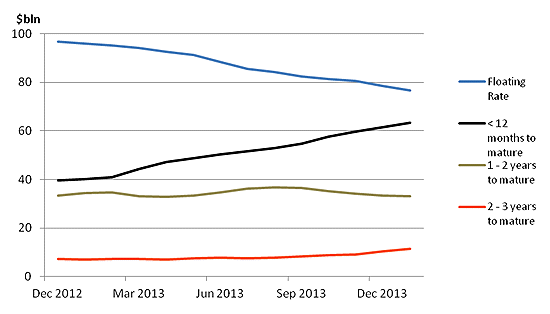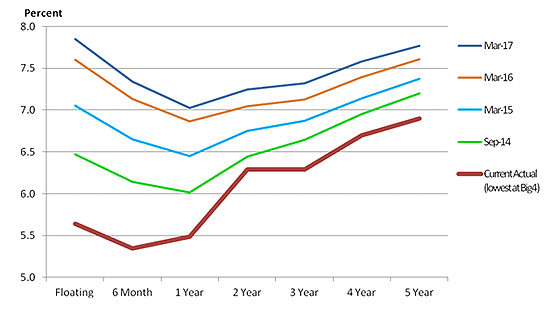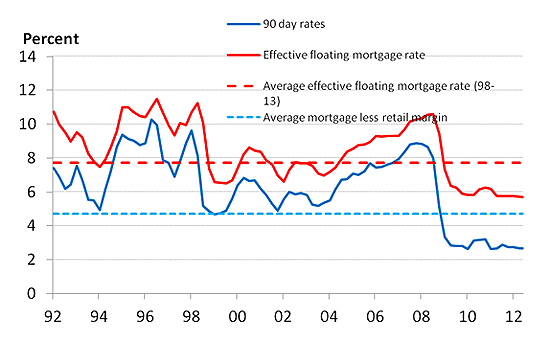
By Mark Brown*
 This month the Reserve Bank began its first concerted rate hike program for ten years.1
This month the Reserve Bank began its first concerted rate hike program for ten years.1
Exactly how households, businesses and financial markets will bear up under the projected shift higher in rates is a matter of considerable uncertainty.
The Reserve Bank, knowing that monetary policy operates with a lag, will need to make judgements about how the economy and inflation will behave.
With the majority of outstanding household mortgages on a floating rate, or short-term fixed rate, the commonly held view has been that rate hikes will be felt quite quickly.
However, our analysis of the mortgage market highlights that it may take 6 months or more before the Reserve Bank rate hikes result in materially higher fixed rate mortgage rates.
As a result, initial RBNZ action may have a muted impact on consumer confidence.
In the meantime, we are expecting strong economic momentum to continue.
Speculation of a more aggressive tightening cycle could develop.
It is into 2015 that the mood may shift.
Although the Reserve Bank is forward-looking, they will be faced with the information in front of them and it could become increasingly difficult to be confident inflation will stay close to their 2% target, based on projected monetary policy settings..
Strong, strong momentum
At present, with the economy in splendid shape, households and businesses feel pretty resilient.
The terms of trade are at 40-year highs, with strong export prices seen beyond just the dairy sector; construction is strong in Canterbury and growing in Auckland; migration inflows are substantial, which is increasing demand for housing; and a positive job market is supporting confidence. Latest data suggest these influences are persisting at a high level.
The only sign of change so far has been in the housing market, where the LVR policy has affected demand from investors and first-home buyers.
The banks initially reacted by curtailing the supply of mortgage-lending to the high-LVR sector.
However they now seem to be fully back into competitive mode, with aggressive fixed rate offers providing an offset to the recent OCR hike.
Looming mortgage-refixing
New Zealanders have a strong record of opting for the lowest mortgage rates available. It’s probably been a good strategy in the past. Over recent times, that has meant the bulk have congregated between floating and 1 year mortgages. So, while many people have switched from floating to fixed, those fixed deals will come up to roll through 2014. Consequently, borrowers will face rate hikes relatively quickly, compared to the mid-2000s when longer-term fixed rate mortgages were ‘de rigueur.’
Chart 1: Outstanding Residential Mortgages

Source: Reserve Bank of New Zealand
While available data is not sufficiently granular to provide the detail we would wish for, our analysis suggests the busy phases of existing fixed rate mortgages rolling off will occur during March-April, then September-December.
Borrowers considering mortgage rates now are likely to face different pricing through the course of the year and into the future.
To get a sense of possible mortgage rates in the future, a useful exercise is to use current market interest rates to determine what the market thinks pricing will be in the future. To do this we look at the interest rate swaps market, which is heavily influenced by the Reserve Bank’s own OCR projections. From there we need to add bank funding cost margins and typical bank profit margins to estimate where banks might set fixed and floating rate mortgages.
This analysis allows us to estimate where the market is implicitly projecting all mortgage pricing from the floating rate to 5 year fixed mortgages at any point in time over the next 5 years.2 Chart 2 below compares the current mortgage yield curve with projections 6, 12 and 24 months ahead. For current mortgage rates, we’ve used the lowest quoted rate from the 5 major banks (ASB, ANZ, BNZ, Kiwibank and Westpac).
Chart 2: Mortgage rates into the future, based on prevailing market interest rates.

Source: Bloomberg, www.interest.co.nz, Harbour Asset Management Ltd. As at 21 March 2014.
An important caveat is that as market interest rates change, the mortgage rates projected above will also change. Chart 2 is only a snapshot of current market expectations.
While we must be cautious about treating the projections above with a sense of certainty, there are some broad observations that we believe can be taken:-
-
Mortgage rates are expected to rise over time.
-
The shift in rates is more pronounced for floating, 6 month and 1 year mortgage rates.
-
In 12 months time, market pricing suggests all mortgage rates will be above the current 2 and 3 year fixed rates.
-
By March 2017, floating rate mortgages could reach 8%.
- Over the next 6 months, mortgage rates do not reach levels that would be likely to cause serious concerns for mortgage holders.
An additional interpretation one can take from the projected mortgage yield curves, is that one would expect households to increasingly shift to fixed rate mortgages as the floating rate rises. Chart 2 shows that if the floating mortgage rate rises to around 7.0% by March 2015, the one-year rate might have risen only to 6.5%. If this is the case, the Reserve Bank gets a little less for their rate hikes than expected.
Banks have historically earned a larger margin on floating rate mortgages, as they compete for new business in the fixed rate space. With a large proportion of borrowers on floating rates at present, a shift into fixed rates gives borrowers access to rates at tighter margins. Our expectation is that this dynamic will continue and is the reason why the projected yield curves in Chart 2 have a concave shape.
Chart 3: Benchmark Interest Rates

How will the year unfold?
From the analysis above, if economic strength continues, it is probable that we will see a steady rise in mortgage rates, with borrowers still able to find fixed term rates at relatively palatable levels though 2014, even if the window for appealing 3 year fixes is closing fast.
Given the strength of the broader economy, it doesn’t seem likely that consumption across the broader economy will fall sharply, even though there are without doubt households with very little wriggle room right now.
Will households, knowing rises are coming, adjust behaviour now?
That is arguably a rational approach, and a possibility the Reserve Bank is sensitive to. In our mind, this will be a factor, but not as pressing as the times when monthly household cash flow actually sees the mortgage payments increase. Remember that consumer confidence indicators are very high at present.
There are also upside risks to inflation.
Wage pressure, which has been well contained over recent years, could accelerate. Job growth picked up in 2012 and the unemployment rate fell, so this is a metric to watch.
In addition, the non-tradables component of inflation has been constrained by the upward trend in the New Zealand Dollar. That trend is still intact, but with the Kiwi looking over-valued, it is harder to extrapolate.
In 2015, if the US Federal Reserve starts raising interest rates and that coincides with our Terms of Trade easing back, one might expect the Kiwi to decline, prompting non-tradables inflation to rise.
While that is still a medium term story, it would feature in the Reserve Bank’s forecast horizon, and therefore affect monetary policy decisions.
Looking further ahead
While the economy is in a terrific sweet spot at present (and so much more so than Australia and nearly every other major economy), there are aspects that will cause growth to ease back through 2015.
Very high global dairy prices are incentivizing a supply reaction, so our terms of trade should drift back a little.
The Canterbury rebuild will peak, at least in terms of generating incremental growth. Monetary policy does work; mortgage hikes will have an increasing impact. Strong net migration flows could ease back if the Australian economy does improve, as we expect.
It could get tougher for the Reserve Bank
We think 2014 will be a real test for the Reserve Bank’s monetary policy team.
Until recently, sitting on very easy policy has been a very easy decision. Our scenario of strong activity now, with inflation pressures slowly building, followed by an easing back of growth in 2015 might sound almost benign, with a steady path back towards normal monetary conditions (an OCR around 4.0 – 4.5%) a simple exercise.
But as monetary policy acts with around an 18 month lag, there is considerable scope for drift away from a comfortable scenario.
Our analysis of the mortgage market highlights that it may take 6 months or more before the Reserve Bank rate hikes result in materially higher fixed rate mortgage rates.
As a result, initial RBNZ action may have a muted impact on consumer confidence. In the meantime, we are expecting strong economic momentum to continue. Speculation of a more aggressive tightening cycle could develop.
One step at a time
As investors, while mindful of the challenges, we are not inclined to get too far ahead of ourselves.
Thinking about the chronology of the economic cycle is important. For the next few months we expect the ongoing strong data to dominate market sentiment.
Provided the global economy continues it steady improvement, we expect the Reserve Bank to push ahead with hikes, most probably raising the OCR 25 basis points at each of the April, June and July meetings.
From then, the markets will pay very close attention to the developing economic data and the Reserve Bank’s interpretation of the outlook for 2015 as they determine what further policy action is required.
-------------------------------------------------------------------------------------
[1] The Official Cash Rate was raised from 5.0% to 8.25% between March 2004 and July 2007. In 2010 the OCR was hiked modestly, from 2.5% to 3.0%, prior to the Christchurch earthquakes.
[2] Note: Market interest rates change continually. As they change, the projected mortgage rates also change. Therefore the charts above are a snapshot based on current market rates and these will change through time.
-------------------------------------------------------------------------------------
Mark Brown is a director and portfolio manager at Harbour Asset Management. You can contact him here.
2 Comments
The 2010 hikes from 2.5 to 3.0% were soon viewed as a foolish mistake by the RBNZ & most informed commentators well before the Chch large earthquake. Economists & banks mistakenly thought the total destruction of Lehman Bro & the GFC was some kind of minor glitch with a soon return to old normal.
This time rbnz may be carefully hiking gently to give some headroom for the next round of cuts when GFC 2 kicks in.
John Key will also be making sure the hiking is as gentle as possible with the election looming.
Thoughtful analysis as above, from purely a/the - each of lending bank/s would also be helpful.
eg. dealing with RBNZ, maximising/optimising margin, market share, internal rate of return (their own share price) and credit growth.
for it is they that are the "market" we are looking to understand (and you can count them on one hand) / model.
We welcome your comments below. If you are not already registered, please register to comment
Remember we welcome robust, respectful and insightful debate. We don't welcome abusive or defamatory comments and will de-register those repeatedly making such comments. Our current comment policy is here.